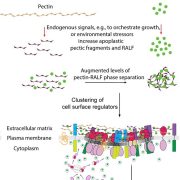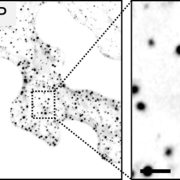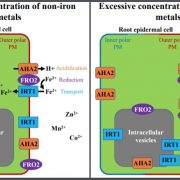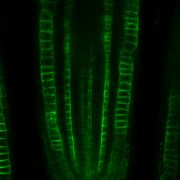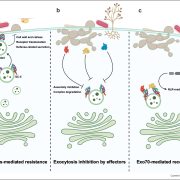The Plant Cell in a Nutshell: The dance of the vesicles
Yan and co-workers follow the localization of various membrane proteins upon blocking clathrin- and adaptor protein-mediated membrane trafficking, and reveal that blocking endocytosis reduces exocytosis (and vice-versa). https://doi.org/10.1093/plcell/koab180
By Xu Yan, Yutong Wang, Dana A. Dahhan, and Sebastian Y. Bednarek
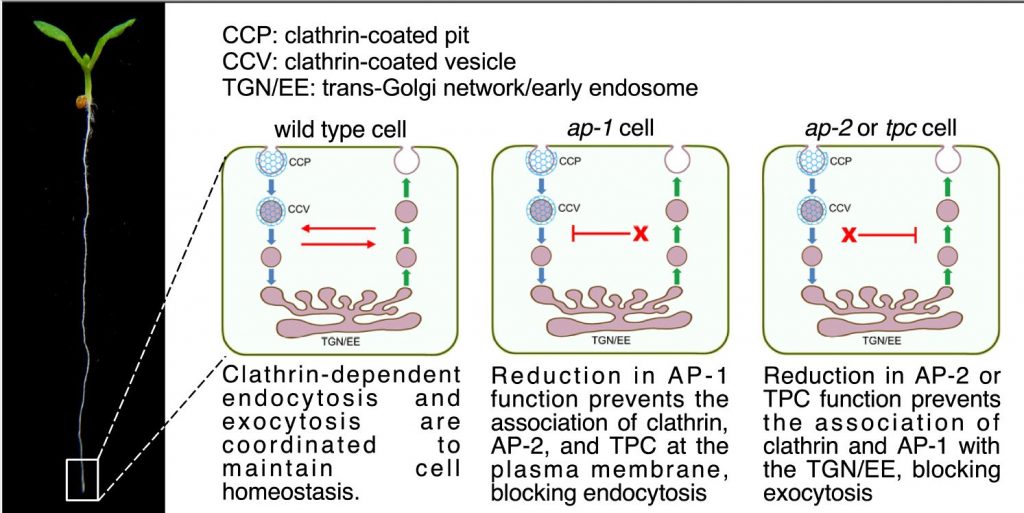 Background: The plasma membrane separates the inside of cells from the outside environment, thereby regulating the entry and exit of molecules and signals to and from cells. Proteins that function at the plasma membrane are produced and modified within cellular “factories”, the endoplasmic reticulum and the Golgi apparatus, prior to their delivery from the main “distribution center” in the cell, the trans-Golgi network/early endosome (TGN/EE), to the cell surface via a process called exocytosis. Simultaneously, cell surface proteins are internalized through endocytosis to the TGN/EE from which they can be re-distributed back to the plasma membrane or to the vacuole for degradation. The mechanisms that coordinate exocytosis and endocytosis to regulate the levels of plasma membrane proteins are unknown. However, plant genomes do encode components of the clathrin and AP-1 adaptor complexes, which are critical for the budding of vesicles from membranes.
Background: The plasma membrane separates the inside of cells from the outside environment, thereby regulating the entry and exit of molecules and signals to and from cells. Proteins that function at the plasma membrane are produced and modified within cellular “factories”, the endoplasmic reticulum and the Golgi apparatus, prior to their delivery from the main “distribution center” in the cell, the trans-Golgi network/early endosome (TGN/EE), to the cell surface via a process called exocytosis. Simultaneously, cell surface proteins are internalized through endocytosis to the TGN/EE from which they can be re-distributed back to the plasma membrane or to the vacuole for degradation. The mechanisms that coordinate exocytosis and endocytosis to regulate the levels of plasma membrane proteins are unknown. However, plant genomes do encode components of the clathrin and AP-1 adaptor complexes, which are critical for the budding of vesicles from membranes.
Question: Is the recruitment of clathrin and clathrin-associated proteins involved in exocytosis from the TGN/EE and in endocytosis from the plasma membrane coordinately regulated?
Findings: Disruption of clathrin-mediated endocytosis in the model plant Arabidopsis thaliana reduced the association of clathrin and the adaptor protein AP-1 with the TGN/EE, thereby inhibiting trafficking of plasma membrane proteins from the TGN/EE. In turn, genetic disruption of AP-1 function or chemical inhibition of exocytosis inhibited the plasma membrane association of the AP-2 adaptor protein and the TPLATE complex, resulting in reduced clathrin-mediated endocytosis. These results strongly indicate that endocytosis and exocytosis are coupled in plant cells through the membrane recruitment of clathrin and its adaptor proteins to the TGN/EE and plasma membrane.
Next steps: The signaling mechanisms that coordinate clathrin-dependent endocytosis and exocytosis pathways need to identified.
Reference: Xu Yan, Yutong Wang, Mei Xu, Dana A. Dahhan, Chan Liu, Yan Zhang, Jinxing Lin, Sebastian Y. Bednarek and Jianwei Pan (2021). Cross-Talk between Clathrin-Dependent Post-Golgi Trafficking and Clathrin-Mediated Endocytosis in Arabidopsis Root Cells. The Plant Cell, https://doi.org/10.1093/plcell/koab180


